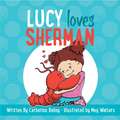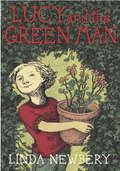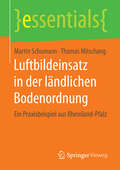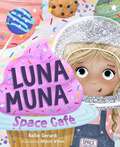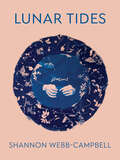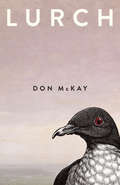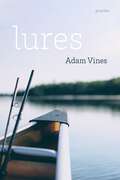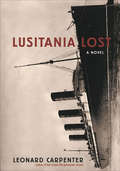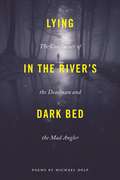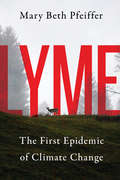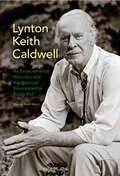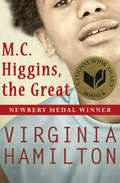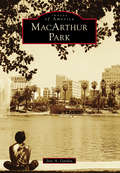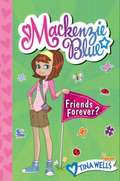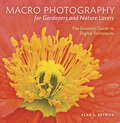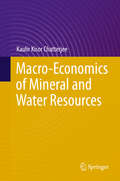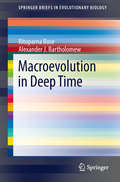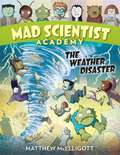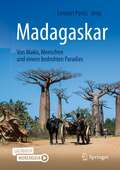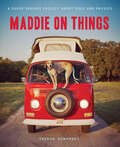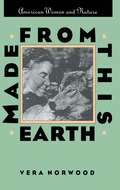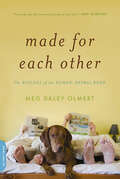- Table View
- List View
Lucy Loves Sherman
by Catherine Bailey Meg WaltersRecipient of the 2018 Florida Authors & Publishers Association (FAPA) Book AwardsSilver Medal in Children's Picture Book ages 0-7 Gold Medal in Children's Picture Book ages 5-9 Silver Medal in Florida: Children's Picture Book ages 0-7 Recipient of a silver IPPY Award for Best Illustrated Children's Picture ebook!Girl meets lobster. Girl loves lobster. But can girl save lobster?That’s the question at the center of this sweet and sassy picture book about Lucy, her shell-y friend Sherman, and the seafood-loving town they inhabit.Lucy loves Sherman from the moment they meet at Flotsam’s Fish Market. Oh sure, he’s an eighteen-pound, eighty-year-old crustacean, but he’s also polka dotted. And blurble-y. And he smells like the ocean! Unfortunately, Nana is not hooked on the idea of a pet lobster.Things only get worse when Lucy meets Chef Pierre and discovers that Sherman’s fate is on a plate! She must rescue Sherman, even if it means getting into hot water with all the grownups. So Lucy takes action. But will the efforts of one little girl be enough to save Sherman from the bib and butter?As humorous as it is inspiring, Lucy Loves Sherman explores an unlikely, yet utterly charming friendship, and the challenge and thrill of finding your voice and being an activist.
Lucy and the Green Man
by Linda NewberyLucy knew Lob was there, from the way she felt inside. There was a sparking of mischief in her head, a tingle of energy in her arms and legs. She wanted to run, jump, climb, be everywhere at once. You have to be a special person to see Lob, that’s what Lucy’s Grandpa Will says. Lucy’s parents don’t believe in him. But Lucy does. And then she finally catches sight of the Green Man in Grandpa’s garden. And then she knows. Lob is here, and he is real-now and forever and ever! From the Hardcover edition.
Luftbildeinsatz in der ländlichen Bodenordnung: Ein Praxisbeispiel aus Rheinland-Pfalz (essentials)
by Martin Schumann Thomas MitschangIn diesem essential beschreiben Martin Schumann und Thomas Mitschang die Verwendung von Luftbildern in der Flurbereinigungsverwaltung Rheinland-Pfalz. Anhand eines Beispiels stellen die Autoren die Bedeutung der Luftbilder für die Planung von Landentwicklungsmaßnahmen dar. Seit den fünfziger Jahren des letzten Jahrhunderts werden Luftbilder für die unterschiedlichen Zwecke eingesetzt. Dabei haben sich die Qualität der Aufnahmen sowie die Auswertungsmöglichkeiten im Laufe der Jahrzehnte verändert.
Luna Muna: Space Café (Luna Muna Ser.)
by Kellie GerardiLuna Muna: Space Café (Ages 4-8)3…2…1… Bake Sale! Luna Muna, our fearless future space explorer, takes us on another adventure with some out-of-this-world treats in the mix!When Luna Muna’s science class hosts a bake sale fundraiser, Luna opens her very own space café. Running a bakery isn’t as easy as she expected! Just when everything is starting to look like one giant, galactic mess, Luna Muna discovers that teamwork and creativity just might be able to save the day… and the treats!Learn about teamwork, creative thinking, space travel and space facts. Luna Muna is determined to open up her very own space café and create cosmic treats. After a series of messy mishaps, friends with helping hands save the day! Throughout her bake sale adventure, Luna Muna teaches about outer space, our solar system, space facts, and the mysteries of the universe with delicious baked treats. Luna Muna: Space Café is perfect for future space explorers, scientists, and parents looking for space books for kids. Luna Muna: Space Café is also the perfect book for 4 year olds and older who love adventure, imagination, space, science, or treats!Inside, you’ll find:A recipe for your own cosmic and delicious treatA space adventure that teaches about teamwork and creativityBeautiful illustrations and yummy treatsAn early understanding of space exploration, space facts, and astronomy for kidsIf you're looking for baking books for kids, gifts for young girls or gift books for kids who love adventures among the stars and the best space books around, add this book to your list. If your child liked Busy Betty, Rylee The Young Rocketeer, or The Tasty Adventures of Rose Honey Books, they’ll love Luna Muna: Space Café.
Lunar Tides
by Shannon Webb-CampbellExpansive and enveloping, Webb-Campbell's collection asks, "Who am I in relation to the moon?" These poems explore the primordial connections between love, grief, and water, structured within the lunar calendar. The poetics follow rhythms of the body, the tides, the moon, and long, deep familial relationships that are both personal and ancestral. Originating from Webb-Campbell's deep grief of losing her mother, Lunar Tides charts the arc to finding her again in the waves. Written from a mixed Mi'kmaq/settler perspective, this work also explores the legacies of colonialism, kinship and Indigenous resurgence.Lunar Tides is the ocean floor and a moonlit night: full of possibility and fundamental connections.Praise for Lunar Tides"In Lunar Tides, Shannon Webb-Campbell exposes a heart that's broken but also carried across the gulf between the moon and the sea, a heart that knows how "grief takes up with the body." She shows us that grief is tidal, its ebb and flow pulsing like the moon and dog-earring our memories. This book reminds us that, grieving or not, we "need to be held by something other than a theory." —Douglas Walbourne-Gough, author of Crow Gulch"Lunar Tides is both expansive and exacting, inviting us to feel our own relationship to the ocean, belonging and mortality." —Shalan Joudry, author of Walking Ground
Lurch
by Don McKay"[McKay's] exuberantly musical and shrewd poems are ecological in the fullest sense of the word: they seek to elucidate our relationships with our fragile dwelling places both on the earth and in our own skins." --New York Times Book ReviewAn extraordinary collection of poems from Griffin Poetry Prize winner Don McKay. Old joke: &“What&’s the difference between a lurch and a dance step?&” &“I don&’t know.&” &“I didn&’t think so. Let&’s sit down.&” These poems are what happens when you stay out on the dance floor instead, dancing the staggers. The full moon rises from the ocean and you lurch with astonishment that we live on a rocky sphere whirling in space. Or the bird in your hand—a pipit or a storm petrel—conveys the exquisite frailty of existence. And there&’s the complex of lurches as we contemplate our complicity in the sixth mass extinction. Throughout Lurch, language dances its ardent incompetence as a translator of &“the profane wonders of the wilderness,&” whether manifest as Balsam Fir, Catbirds, the extinct Eskimo Curlew, or the ever-present Cosmic Microwave Background. What is the difference between a love song and an elegy? We live between eroding raindrops and accelerating clocks. The piano lifts its lid to show its wire-and-hammer heart.
Lures: Poems
by Adam VinesWritten almost exclusively in traditional, modified, and nonce forms, the poems in Lures renegotiate grief, trauma, southern masculinities, and fatherhood with unflinching resolve. This new collection by Adam Vines draws much of its subject matter and imagery from fishing, revealing how close observations of species, spawning cycles, predation and feeding patterns, underwater topographies, water clarity, and lure choice reflect larger themes of what it means to be lured through memories of those who have passed and those who remain present. With Lures, Vines proposes that by reconstructing the stories from our past, we gain a greater understanding of our cultural identities and inheritances from those who made an impact on our lives.
Lusitania Lost: A Novel
by Leonard CarpenterA World War I spy thriller from an author who puts “electrifying action into everything he writes” (Jonathan Maberry, New York Times–bestselling author). Alma Brady is on the run from a New York mob boss. Desperate to escape Big Jim Hogan and his murderous gang, she joins a group of nurses bound for the Great War in Europe. Their ship is the Lusitania, the most celebrated luxury liner of 1915, with a passenger list of Broadway and Continental celebrities—who do not realize they are headed for certain doom. Aboard the ship she meets Matthew Vane, a war correspondent who wants to find out what secret weapons may be hidden in the Lusitania cargo hold. During the one-week voyage, these characters will be drawn into romance, intrigue and murder, in an epic historical thriller that takes us above and below decks, into the German U-boat lurking nearby, and to the capitals and battlefields of Europe. “Anyone who thrilled to the Titanic film will love this book.” —Sandra Nielsen
Lying in the River's Dark Bed: The Confluence of the Deadman and the Mad Angler (Made in Michigan Writers Series)
by Michael DelpLying in the River's Dark Bed: The Confluence of the Deadman and the Mad Angler by Michael Delp is a collection of fifty-six poems that brings together two characters Delp has been perfecting for years: Deadman and the Mad Angler. The Deadman, a spirit that constantly shifts, is one part troublemaker, one part truth-teller, and one part demon who demands respect. The Mad Angler, on the other hand, could be called the Mad Shaman or Mad Activist, as he speaks of the water and nature and then of the greed of man. While these two personas are distinct in the collection (highlighted beautifully in the unique double-sided book design) they also come together at times in perfect harmony. The Deadman and the Mad Angler are walking contradictions--twin sons of different mothers. The Deadman is a trickster figure, a hive of contradictions. He can be killed but cannot die. He is supremely intelligent, yet is as dumb as a stone. He is an enigma to himself and to all others, yet he understands the origins and the meanings of the inner lives of all things. He is impossible to understand, yet somehow through his musings enlightenment occurs. His poems inspire contentedness, even though they might frighten you first in order to do so. The Mad Angler is more finely tuned, focused primarily on the environment. He exercises more restraint and resistance than his scattered brother, focusing on nature and on what is flowing in the water around him and inside of him. His voice is sure and firm on all things water related because he is as much river as person. The collection embraces these voices as separate and unique identities, while highlighting a center section called "Confluence," the place where these two come together to meditate on some of the most profound emotions evoked by the contemporary world. Lying in the River's Dark Bed reflects the compatibilities and contradictions of the natural world. These ritualized poems are both funny and thought provoking and an example of persona writing at its best. Those interested in conversational poetry and environmental writing will be enthralled with this stirring yet soothing collection.
Lyme: The First Epidemic of Climate Change
by Mary Beth PfeifferLyme disease is spreading rapidly around the globe as ticks move into places they could not survive before. The first epidemic to emerge in the era of climate change, the disease infects half a million people in the US and Europe each year, and untold multitudes in Canada, China, Russia, and Australia.Mary Beth Pfeiffer shows how we have contributed to this growing menace, and how modern medicine has underestimated its danger. She tells the heart-rending stories of families destroyed by a single tick bite, of children disabled, and of one woman's tragic choice after an exhaustive search for a cure.Pfeiffer also warns of the emergence of other tick-borne illnesses that make Lyme more difficult to treat and pose their own grave risks. Lyme is an impeccably researched account of an enigmatic disease, making a powerful case for action to fight ticks, heal patients, and recognize humanity's role in a modern scourge.
Lynton Keith Caldwell: An Environmental Visionary and the National Environmental Policy Act
by Wendy Read Wertz“A solid overview of both Caldwell’s contributions and the development of the environmental movement in the US . . . . Recommended.” —ChoiceThis is the story of a visionary leader, Lynton Keith Caldwell, who in the early 1960s introduced the study of the environment and environmental policy at a time when such areas of expertise did not exist. Caldwell was a principal architect of the National Environmental Policy Act of 1969 and is recognized as the “inventor” of the Act’s important environmental impact statement provisions, now emulated around the world. For the next three decades, Caldwell played a leading role in establishing ethics-based environmental policy and administration as major areas of inquiry in the United States and around the world. Through his tireless global travels, writing, and lectures, and his work with the US Senate, the IUCN, UN, and UNESCO, Caldwell became recognized for his contributions to environmental ethics and the development of strong environmental planning and policy. This engrossing biography is based on interviews the author conducted with Caldwell and on unrestricted access to his memorabilia, photos, and records.“Deeply insightful . . . The field of environmental policy is richer for this addition. —H-Net Reviews
Lynx (Nature's Children)
by Merebeth SwitzerHow do lynx live in their arctic homes? How do they stop from sinking into the snow? Why do they have those tufts of hair on top of their heads? Explore this and much more about the lynx, in this book.
Límites Socioculturales de la Educación Ambiental (Acercamiento desde la experiencia cubana)
by Carlos Jesús Delgado DíazEs evidente que el progreso científico-tecnológico, el bienestar de las sociedades industrializadas y el deterioro del medio ambiente se encuentran profundamente relacionadas. Al minarse las bases de los ciudadanos, la preocupación social por lo ambiental se ha manifestado como una institución social de ese vínculo con la naturaleza demandando una nueva educación que incluya la reflexión y modificación de su relación material con el mundo.
M.C. Higgins, the Great (Multicultural Library)
by Virginia HamiltonHamilton&’s classic coming-of-age tale: The National Book Award– and Newbery Award–winning novel about a young man who must choose between supporting his tight-knit family and pursuing his own dreamsMayo Cornelius Higgins perches on top of a homemade forty-foot tower, considering two destinies. Behind him is his family&’s beloved house at the foot of a mountain that strip mining has reduced to loose rubble. In front of him, the beautiful Ohio River Valley and the great world beyond. As M.C. weighs whether to stay with the family and home he loves or set off into the world on his own, there appear on the horizon two strangers who will make his decision all the more difficult.
Mabberley's Plant-Book
by David J. MabberleyMabberley's Plant-Book is internationally accepted as an essential reference text for anyone studying, growing or writing about plants. In over 20,000 entries this comprehensive dictionary provides information on every family and genus of seed-bearing plant (including gymnosperms) plus ferns and clubmosses, combining taxonomic details and uses with English and other vernacular names. In this new edition each entry has been updated to take into consideration the most recent literature, notably the great advances from molecular analyses, and over 1650 additional new entries (including ecologically and economically important genera of mosses) have been added, ensuring that Mabberley's Plant-Book continues to rank among the most practical and authoritative botanical texts available.
MacArthur Park
by Jose A. GardeaKnown as Westlake Park for its first 60 years, MacArthur Park is considered one of Los Angeles's original parks. Throughout its history, it has endured countless challenges as the neighborhood and city that surround it grew to become the current metropolis. Born out of progressive vision and drought, MacArthur Park, due to its elegant design and cultural programming, has been referred as a "civic jewel" and the West Coast version of Central Park. Like many urban parks, it has also been burdened with a negative image due to its many decades of neglect, crime, and municipal disinvestment. Today, MacArthur Park has survived as a critical green and cultural space for one of the most densely populated neighborhoods in the country. More importantly, MacArthur Park has served as an authentic democratic space for local stakeholders and visitors to gather, play, and protest.
Mackenzie Blue: Friends Forever?
by Tina WellsMackenzie Blue is hitting the trails! It's time for Brookdale Academy's camping field trip, but Zee has much more to deal with than a lesson about nature. . . . Pros: 1. My BFF, Ally, is visiting all the way from Paris! Ooh la la! 2. My friends and I are so going to win the environmental scavenger hunt! Cons: 1. We have to stay in teeny-tiny log cabins. How will we all fit? 2. The legendary (and terrifying) Mountain Man . . .
Macro Photography for Gardeners and Nature Lovers: The Essential Guide to Digital Techniques
by Alan L. DetrickGardeners and nature lovers delight in taking pictures—especially close-ups of flowers, butterflies, and insects. And though advances in digital camera technology have made taking, storing, and sharing photos easier than ever, taking top-quality pictures requires familiarity with both digital technology and the general principles of photography. Macro Photography for Gardeners and Nature Lovers provides exactly the information that aspiring photographers—no matter their level of skill—need to take their photos to the next level. Clear and concise chapters cover the basics of macro (close-up) photography, explain the features of current digital single-lens reflex cameras, show the many ways images can be composed, and share tips on digital effects, storage, and manipulation of imagery. Throughout the text, helpful tips, definitions, exercises, and case studies serve to demystify digital photography. Each lesson is supported by examples of the author's stunning photography. Whether taking photos of flowers and insects, compiling a photographic record of your garden, or simply sharing beautiful images with friends and family, everyone can become accomplished photographers of the world's small-scale wonders.
Macro-Economics of Mineral and Water Resources
by Kaulir Kisor ChatterjeeThis book highlights the indispensability of minerals, the vulnerability of humans and issues faced by governments around the world regarding the management of natural resources. It addresses the growing land-ecology-mining conflicts, energy security and water policies of different countries bringing these issues into focus and critically analyzing them. The book discusses the role of governments regarding the security-centric issues pertaining to sustainability of mineral supply and the welfare-centric aspects of sustainable development of mineral resources. The latter includes the current trends for corporate social responsibility, political viability of mining projects, industrial ethics, human health and human resource development. The Annexure I is unique: It is a list of 925 familiar consumer products and processes with the names of the minerals, metals and rocks as well as the intermediate chemicals and alloys that go into the making of that product or process alongside each. Annexure II is an up-to-date, exhaustive list of about 835 minerals, metals, rocks and intermediate chemicals and alloys and against each of them is a list of the names of the end products and processes for which they are used. These two annexures will serve as a day-to-day reference source for teachers, students and professionals concerned with minerals as well as other interested readers. The book will be useful to any university/institution with undergraduate and post-graduate teaching/research facilities and libraries in the field of geology, mining, mineral economics, planning and natural-resource management. About the Author Kaulir Kisor Chatterjee studied Applied Geology at the Indian School of Mines, Dhanbad for his post-graduate and PhD degrees. He served in the Indian Bureau of Mines for over three decades and retired in early 2004, as Chief Mineral Economist. Post-retirement, he has occupied himself mostly with writing, teaching and lecturing in various institutions of repute in India on the subject of mineral economics. Besides 50 technical papers, he has authored eight books. He has worked in various Government committees and expert groups and was involved in organization of national mineral inventory; UN Framework Classification system of mineral resources; rationalisation of the mineral taxation, royalty and mineral legislation framework in India. He has been examiner and member of selection boards of UPSC, India and is also a recognised guide of the Nagpur University for doctoral research. His resume has been included in the Marquis Who Is Who of the World and in the 2000 Outstanding Intellectuals of the 21st Century, Cambridge.
Macroevolution in Deep Time
by Alexander J. Bartholomew Rituparna BoseThe prerequisite to investigating the underlying causes behind mass extinction is a profound understanding of the evolutionary history of both living and dead species. It is especially important to appreciate the significance of such studies in extinct organisms; especially in organisms that were abundant in a certain geologic era, but have subsequently dwindled or become extinct. Such studies should help to accurately evaluate patterns of evolution in extinct species lineages and help predict the same in its modern analogs. The book includes cutting edge research in evolutionary biology that should serve as a starting point for conservation.
Mad Scientist Academy: The Weather Disaster (Mad Scientist Academy #2)
by Matthew McElligottFans of Ada Twist, Scientist, will want to join Dr. Cosmic&’s class of clever monsters as they face down snow, floods, and a dangerous thunderstorm when freak weather conditions threaten the school in the second book of the Mad Scientist Academy series. Dr. Cosmic can&’t wait to introduce the students to his latest invention, the CHAOS machine, designed to keep the school at the right temperature for learning. But when the machine starts to malfunction, causing extreme weather conditions, the students must use their upgraded handbooks to stop CHAOS before it destroys the entire school! Join Dr. Cosmic&’s clever class of monsters as they solve the greatest challenges in science, in this blend of adventure and exploration, perfect for Common Core and STEM."With outlandish situations rendering scientific concepts memorable, McElligott has concocted a winning formula for learning as entertainment."--Kirkus Reviews"Science fans and comics enthusiasts will dive right into this . . . There's enough fun here for anyone." —School Library Journal"Engaging and educational." —Booklist"No need for MSA kids to take a field trip: what could be more interesting than school?" —The Bulletin
Madagaskar - Von Makis, Menschen und einem bedrohten Paradies
by Lennart PyritzEin Buch, das Madagaskar in seinen vielfältigen Facetten zeigt, untermalt mit ausgezeichneten Fotos. Angesprochen werden alle reise- und naturbegeisterten Leser. Ein tagebuchartiger, amüsant geschriebener Erfahrungsbericht über eine 14-monatige biologische Feldarbeit in Madagaskar in Form kurzer Texte (siehe: www.spektrumdirekt.de/madagaskar) ist ergänzt durch zahlreiche hochqualitative Fotos. Hauptsächlich biologische Themen werden erörtert, aber auch Erfahrungen mit madagassischer Kultur, Land und Leuten. Einzelne Abschnitte werden durch allgemeinverständlich geschriebene Infoboxen von Experten zum jeweiligen Thema ergänzt. Den zweiten Teil des Buches bildet eine Sammlung von Essays mit Fotos, ein madagassisches Zitat am Anfang führt hin zu madagassischer Fauna, Flora, Naturschutz, Geschichte, Politik, Kultur und Lebensweise. Verfasst sind die Beiträge von Autoren wie Prof. Peter Kappeler vom Deutschen Primatenzentrum, Dr. Roland Hilgartner, Leiter des Affenbergs Salem, und seiner madagassischen Frau Mamisolo sowie Dr. Christoph Schwitzer vom Zoo Bristol und Madagaskar-Koordinator der IUCN SSC Primate Specialist Group.
Maddie on Things: A Super Serious Project About Dogs and Physics
by Theron HumphreyA rescue hound demonstrates her knack for balance across America in this heartwarming photography collection.Maddie is a sweet-tempered coonhound who accompanied her owner, Theron, on a yearlong, cross-country trip while he worked on a photojournalism project. In his spare time, Theron took photos of Maddie doing what she does best: standing on things. From bicycles to giant watermelons to horses to people, there really isn’t anything that Maddie won’t stand on with grace and patience. The poignant Instagram photos of this beautiful dog and her offbeat poses have captured the imagination of all those who long for a road trip with a good dog for company. Maddie on Things celebrates the strange talent of one special dog and will resonate with any dog lover who appreciates the quirky hearts (and extraordinary balance) of canines.
Made From This Earth
by Vera NorwoodThe broad sweep of environmental and ecological history has until now been written and understood in predominantly male terms. In Made From This Earth, Vera Norwood explores the relationship of women to the natural environment through the work of writers, illustrators, landscape and garden designers, ornithologists, botanists, biologists, and conservationists.Norwood begins by showing that the study and promotion of botany was an activity deemed appropriate for women in the early 1800s. After highlighting the work of nineteenth-century scientific illustrators and garden designers, she focuses on nature's advocates such as Rachel Carson and Dian Fossey who differed strongly with men on both women's "nature" and the value of the natural world. These women challenged the dominant, male-controlled ideologies, often framing their critique with reference to values arising from the female experience. Norwood concludes with an analysis of the utopian solutions posed by ecofeminists, the most recent group of women to contest men over the meaning and value of nature.
Made for Each Other: The Biology of the Human-animal Bond
by Meg Daley OlmertOxytocin is a hormone that has been implicated in romantic and maternal love. As a producer of nature documentaries for television who participated in research on the neurobiology of social bonding, Olmert examines the evidence for oxytocin as also being the basis for the evolution of the human-animal bond. Her interesting, general audience treatment concludes by noting the facilitators and barriers modern society poses for this relationship. Annotation ©2009 Book News, Inc. , Portland, OR (booknews. com)
